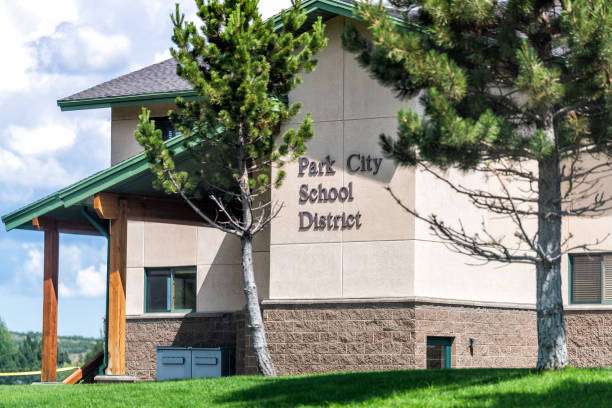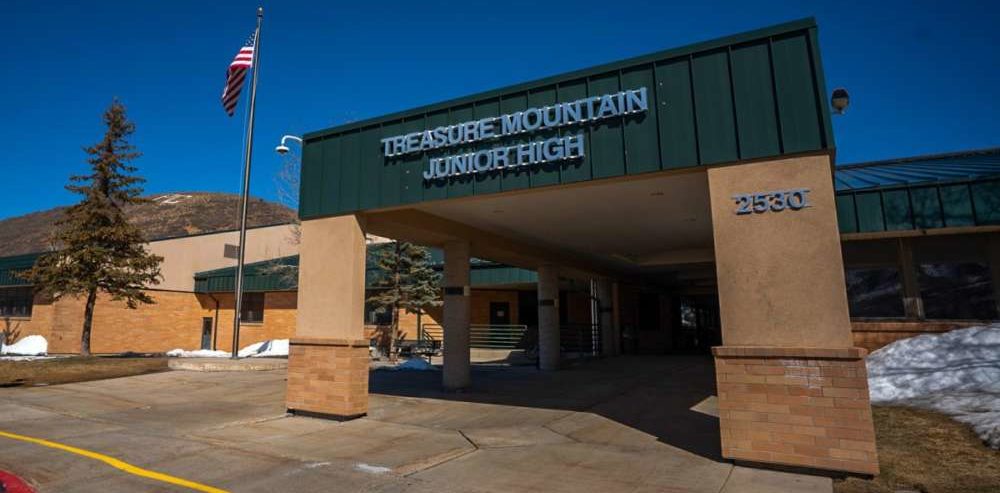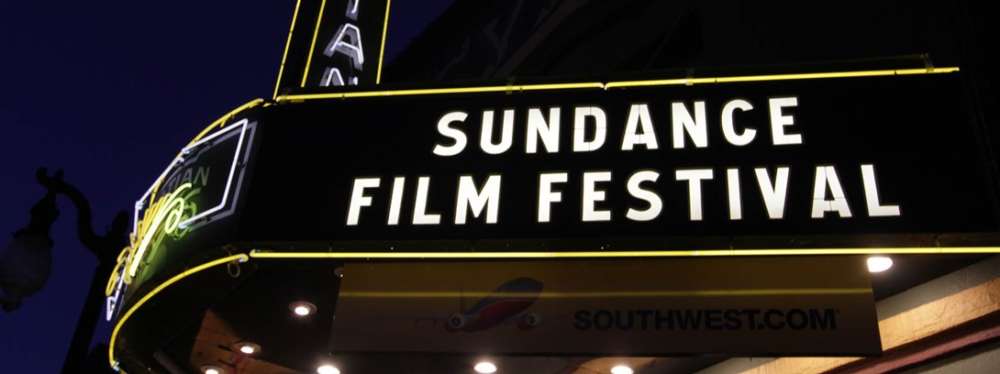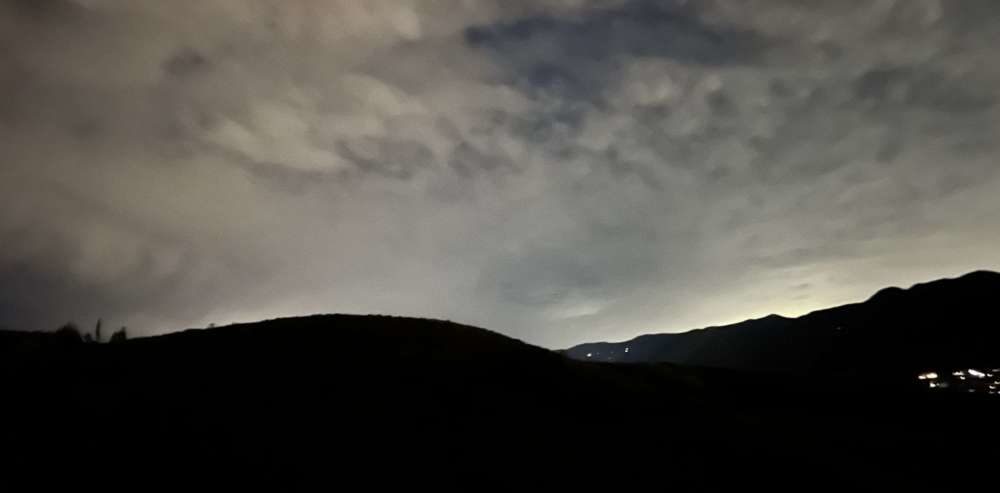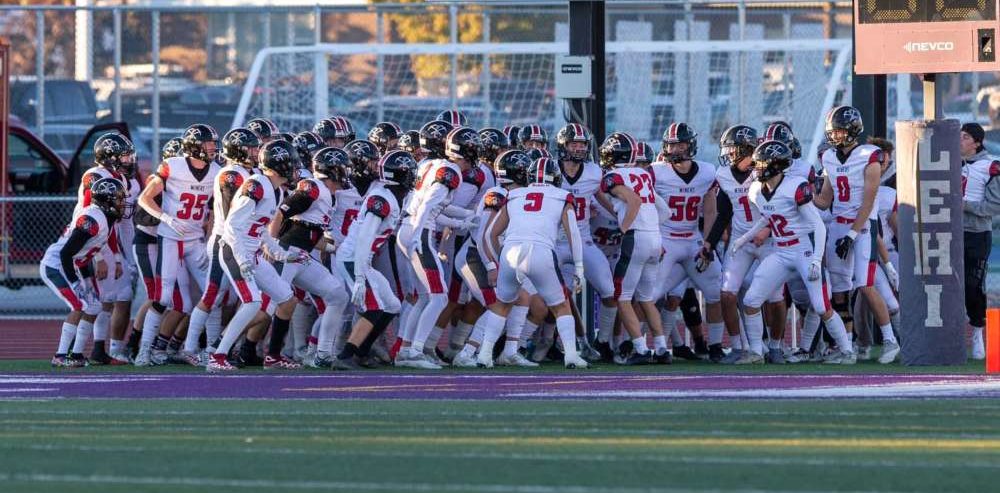How to find the petition and contact the school board
If you would like to review the petition Karl Persson and I launched that asks for the school board to not vote on the superintendent’s contract until the new board assumes office in January, it can be found here:
View Petition
If you would like to email the school board to voice your opinion on whether they should vote to renew the superintendents contract before the new board is seated, the email address is:
Thanks for your support.
PCSD teachers and employees, want to voice your opinion on whether the current board should decide on renewing the Superintendent?
On Sunday, Karl Persson and I launched a petition urging the Park City School Board to delay renewing Superintendent Jill Gildea’s contract until the new school board is seated. School Board President Andrew Caplan stated that the current board intends to vote on Dr. Gildea’s contract, which we believe is inappropriate.
We feel the new school board, seated in January 2025, should make the decision on the superintendent, as they will be responsible for that choice. As of now, we have over 100 signatures supporting this effort, which is incredible.
However, we anticipated not receiving signatures from those closest to our schools — our teachers and district employees. The reason? Fear of retaliation. If they were to sign the petition on Change.org, they might face repercussions from the school district.
In any organization, those closest to the situation can provide the most accurate insights. In this case, that would be the teachers and employees of the Park City School District.
This presents a dilemma.
To address this, we have created a button at the bottom of this page for PCSD employees to show their support for allowing the new school board to decide on renewing Superintendent Gildea’s contract. This way, employees can express their opinions without fear.
Please note, Parkrag will not track your identity, IP address, or location when you click this button. We encourage you to use your personal phone, laptop, or iPad to do so.
Historically, when feedback is requested from employees, the Park City School District often responds by trying to limit employees’ freedom of expression. They usually send an email advising employees not to respond, claiming uncertainty about how their responses will be used.
Let’s circumvent that argument. Here’s exactly how your response will be used: When reporting on the petition and votes, we will state that X number of people have signed the petition. We will also note that we have received X number of anonymous votes from individuals who support the petition but cannot provide their names due to fear of retribution.
That’s it.
I don’t know if you’ll trust Parkrag to vocalize your support. I would hope we have earned your trust.
If you’d like to support the petition without providing your name, please click the button below.
Thank you for your consideration.
Petition to Not Renew Park City Superintendent’s Contract Until New School Board Assumes Office
On June 20th, KPCW’s Leslie Thatcher asked Park City School Board President Andrew Caplan if he was going to let the new school board decide whether to renew Superintendent Jill Gildea’s contract. Dr. Gildea is one year into a two-year contract, and the board must notify her by February 1, 2025, if they intend to renew it.
Mr. Caplan responded, “No, that’s a decision made by this board and will happen this year.”
I believe that is a mistake. The Park City School Board has five members. School Board President Caplan and Vice President Wendy Crossland are not running for reelection this November. Current board member Anne Peters is running against Susan Goldberg in District 1 (Old Town, Prospector, PC Heights). That means at least two and potentially three board members will be new next term. I believe it is the responsibility of this board to leave the decision on renewing the superintendent until a new board is seated.
This is important for five reasons:
- Respect for Electoral Mandate: The newly elected board members represent the most recent preferences and views of the electorate. Allowing them to have a say in significant decisions like renewing the superintendent’s contract aligns with the democratic process.
- Legitimacy and Trust: Renewing a superintendent’s contract just before new members take office undermines the authority of the incoming board. This can create distrust and a perception of illegitimacy, potentially causing friction and reducing overall effectiveness.
- Fresh Perspectives and New Ideas: New board members bring fresh perspectives and may have different views on the superintendent’s performance or the school district’s direction. Their input could be valuable in making an informed decision about the contract renewal. In fact, Andrew Caplan cited New Ideas as a reason for not running for reelection.
- Accountability: The outgoing board might lack accountability to the electorate for decisions made at the end of their term, particularly if they are not seeking re-election. Allowing the new board to make the decision ensures that those who will be accountable for the outcomes are the ones making the decision.
- Transparency and Fairness: Waiting for the new board members to participate in the decision-making process promotes transparency and fairness. It ensures that all relevant stakeholders have a voice in critical decisions affecting the school district’s future.
With this in mind, Karl Persson and I launched a Petition to ask the current school board to adhere to the existing schedule and let the incoming board decide whether to renew Dr. Gildea’s contract. This petition does not ask the board to reject Dr. Gildea’s renewal. It simply asks for the decision to be made by the next school board—the one that will have to live with that decision.
If you support this idea, please consider signing the petition:
Park City School District’s Leadership Faces Severe Criticism in 2024 Staff Survey
Update: Originally, I had written that “A group of advocates surveyed school employees about the Park City School District in 2022 and now again in 2024.” I received comments that felt this implied that all of the same people who were involved with this survey in 2022 were also involved in this iteration. I checked with a member of the group , and not all people involved in 2022 were involved in this survey.
I am sorry for the confusion. I have updated the language. Please see a note at the bottom of this page for information from Educational Advocates.
In April, school employees were surveyed about the Park City School District. This was an anonymous survey from an outside group called Educational Advocates.
I found several interesting takeaways from the survey:
- Principals scored better than the Superintendent in all areas.
- Board members scored very poorly in all areas surveyed.
- The Superintendent scored poorly in all areas.
- 64% of participants either don’t know, disagree or strongly disagree that workplace conflicts are addressed promptly and professionally.
- 32% of participants feel they have the resources and tools to work effectively.
- 48% of participants either don’t know or disagree that serious issues, such as bullying, hate speech, and discriminatory behavior, are addressed quickly, fairly, and professionally in the workplace.
For transparency, I want to disclose my personal background and biases. I ran for the school board in 2022 but did not win. Additionally, I have concerns about the Superintendent’s leadership, believing that her tenure has been marred by numerous scandals in Park City.
With that context in mind, let’s examine some charts and data related to the board of education (school board).
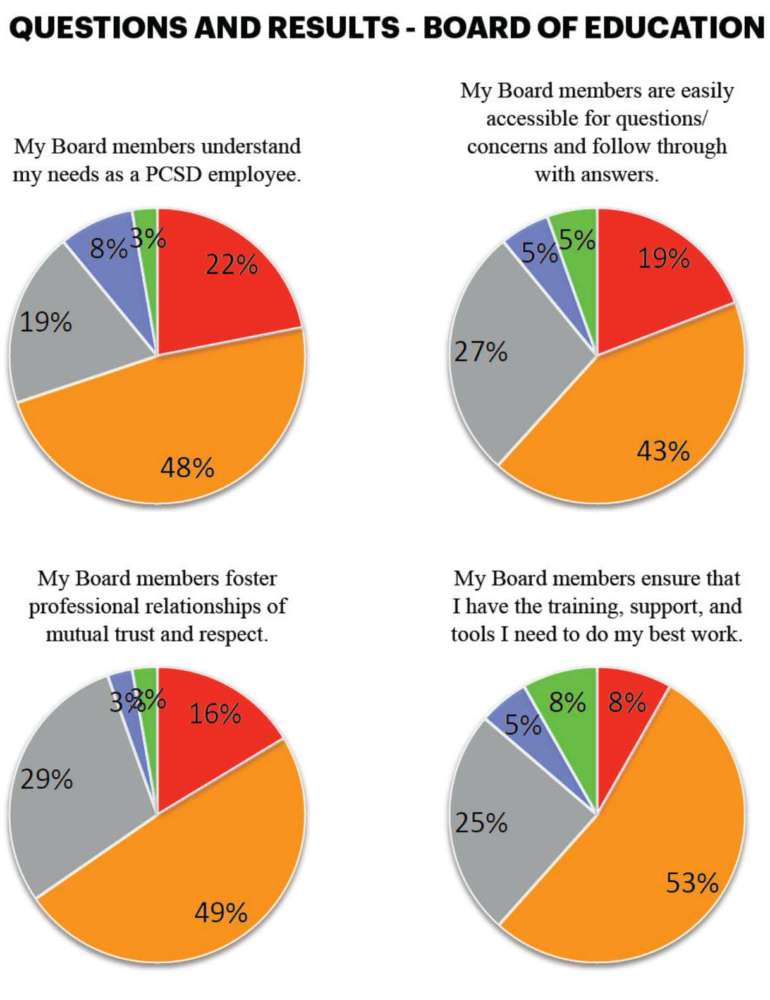
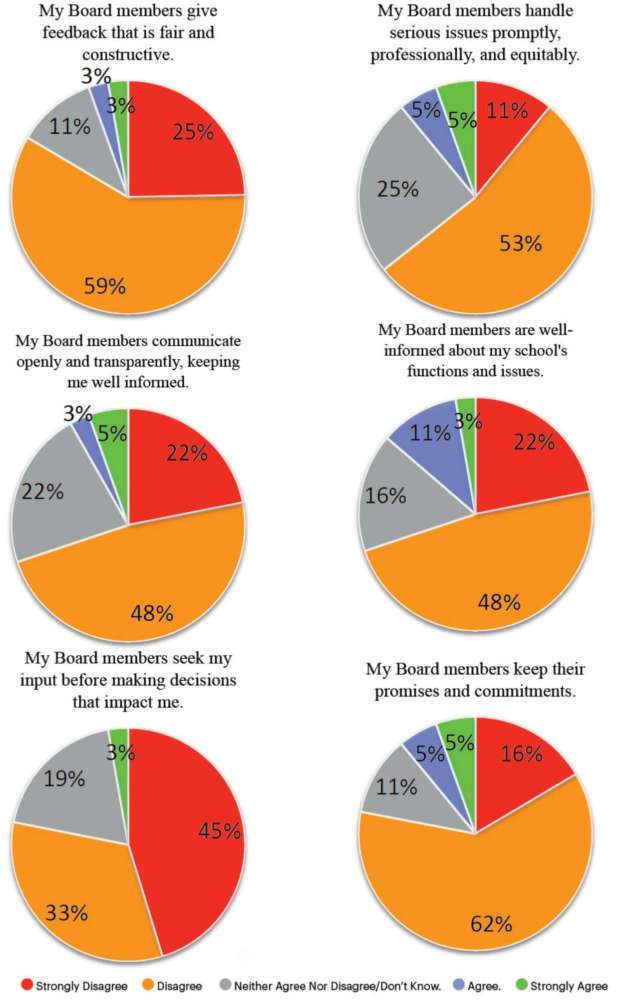
It’s scathing. I had hoped that the new board members would improve the school district, but that’s not apparent in this survey.
- 70% believe the Board members don’t keep their commitments
- 84% feel the Board isn’t transparent
- 70% feel the Board doesn’t understand employee needs
The Board’s best metrics were “The district policies that impact my job are reasonable” and “My Board members know and adhere to education laws, codes, guidelines, and rules” with 30% agreeing on each.
For the Superintendent, it is almost as bad.
- 62% of respondents feel the Superintendent isn’t informed about their school’s issues
- 66% feel the Superintendent doesn’t communicate transparently and openly to keep employees informed
- 61% feel the Superintendent doesn’t keep her promises and commitments.
The Superintendent’s best metric was “My Superintendent knows and adheres to district policies” with 41% agreeing.
When I receive a survey like this, I look for indicators of potential bias. For instance, if all responses are overwhelmingly negative, it raises suspicion that the results may be skewed by disgruntled employees.
However, in this particular survey, it is noteworthy that Principals are generally well-regarded.
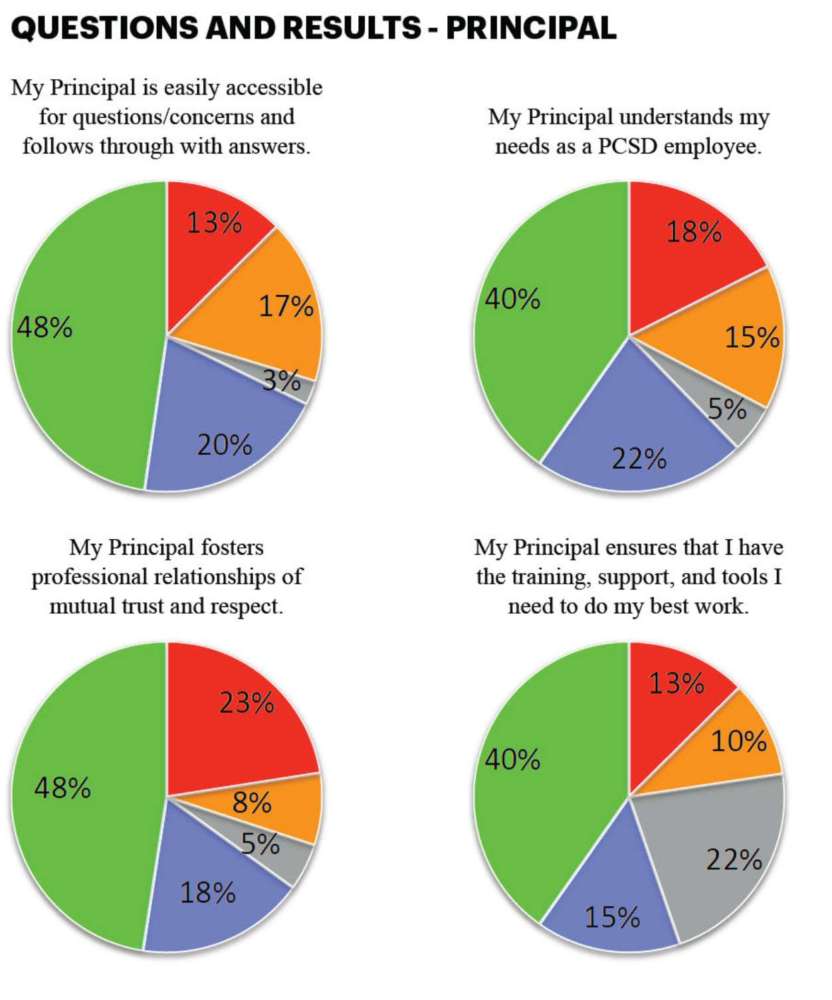
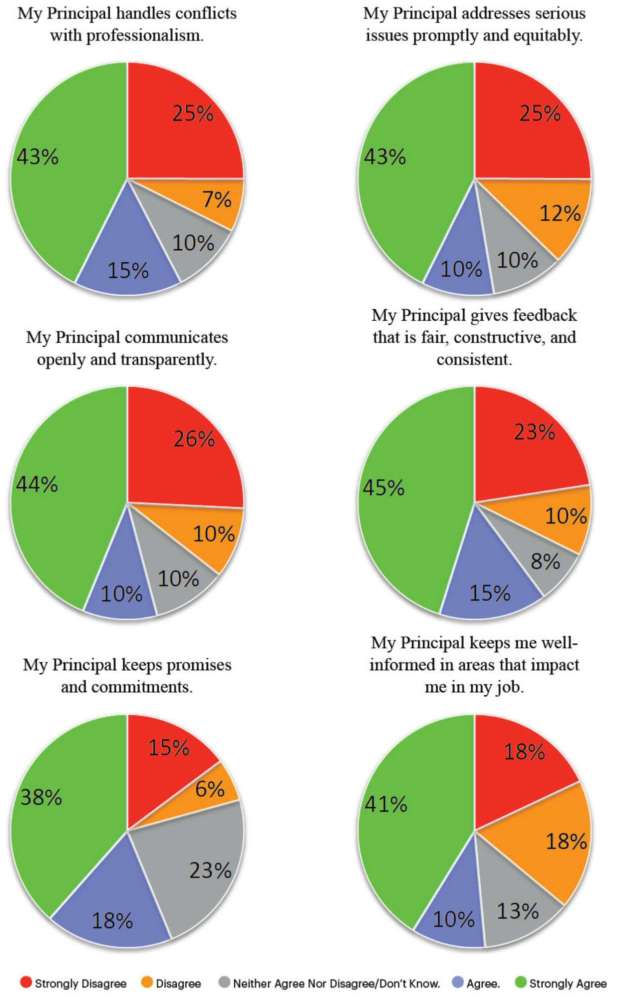
I would think disgruntled employees would rate their closest “superior” negatively. That’s clearly not the case. So, the fact that Principals and Assistant Principals were rated so highly tends to confirm the low ratings of the Board and the Superintendent.
I’d be remiss if I didn’t call out one problem with this survey: participation.
In 2024, 453 employees were emailed, 297 opened the email, and 46 responded with answers. That’s a 16% response rate for those who opened the email, which is not great.
According to the survey, “within hours of survey delivery to employees, the PCSD District Office and Principals issued emails or verbal warnings to employees discouraging participation or urging employees to use caution, which we believe had significant impact in survey participation.”
Regardless of the reason, it isn’t as complete a view into the world of our schools as one would hope. Perhaps the other 84% that didn’t respond don’t have an opinion.
My takeaway is that there is value in the opinion of the 16% — especially since feedback was both positive and negative.
If you are interested, I would encourage you to read the survey. Near the end, you’ll get great feedback from survey participants like:
- “My job would be more satisfying if I had less meetings and data graphs to fill out. I need more time to create and personalize lessons.”
- “I feel that we as a system cater to those who resist change. This is why we have seen so little change to our education practices in my 25+ years in education. We can do sooo much more. We have the knowledge. We have example schools. We have the skills. We have the talent… We need to do it. What are we waiting for?”
- “I’m living the dream”
- “I’ve already commented quite a bit on this! PCSD is not only top heavy, it’s top heavy with people that don’t directly impact the children in our district. It’s so frustrating, and the community should be alarmed.”
Overall the survey provides a glimpse into how some employees view the district. I would encourage you to read the the entire survey here.
A note from Educational Advocates on the Survey:
This PCSD employee survey was prompted by the need for employees to speak up without fear of retaliation from upper management. It was created initially by a group of about twelve stakeholders, including a few PCSD employees who consulted on the questions posed, an employee of the State BOE, a survey expert consultant, and members of the PCSD parent and taxpayer community. This group came together with a singular goal of implementing a high-quality, unbiased employee survey wherein employees could provide positive and negative feedback about our local school system. The anonymity of all parties involved is not just a requirement but a condition for personal safety and the survey’s integrity.
For creators, anonymity:
– reduces bias and influence
– minimizes the risk of respondents being influenced by who is conducting the survey
– protects from potential harassment or retribution
– maintains objectivity of the survey process, focusing on data collection rather than the individuals collecting it
– enhances credibility of the survey results, underscoring impartiality and confidentiality of the data collection process
For employees, anonymity:
– encourages honesty, leading to more accurate and valuable insights
– reduces fear of retaliation from peers and supervisors
– generally increases participation rates
– demonstrates that the survey conductors value and respect employee privacy
– increases diversity and detail in responses, providing a richer dataset and more actionable insights for improving the workplace environment.
We urge PCSD and our community not to speculate about the identities of creators and participants.
Are your kids bullied in Park City Schools?
I remember walking down a hall in Junior High in the middle of Kansas. My friend Tim and I would walk the long hall, and way too often, someone would come up behind Tim and punch his books out of his hands. Papers would fly; books would scatter.
“Dork”
“Loser”
“Faggot”
… would be shouted by the bully as he walked off — triumphant in whatever game he thought he was playing.
Thirty years on, I can still picture it in detail. It was terrible.
I wish bullying was some artifact relegated to my teenage years and a John Hughes movie, but it seems to be alive and well in Park City in 2023.
I’m hearing from parents that their kids are being bullied in Park City schools, and nothing is being done. Worse, I am hearing that school district officials have been notified and are not intervening. Instead, officials are offering platitudes.
If your child is experiencing this, they aren’t alone. There are asshole kids, asshole parents, and teachers and administrators who sometimes don’t do much about it.
I’ve met with parents who are organizing to stop this behavior in Park City schools. If you are having trouble and would like to be put in contact with parents who have children in similar circumstances, please reach out to me at . I will put you in contact with people who are having similar issues and want to make a change.
I know it’s not easy. However, together, we can make things better.
Since the Park City School District hasn’t removed lead-laced soil near Treasure Mountain Junior High, the EPA may take over.
The Park City School District is teaching a masterclass on deflecting, delaying, and denying responsibility. Fortunately, for our children’s sake, the class is almost over.
Since 2017 the Park City School District (PCSD) has been storing soil with lead and arsenic next to Treasure Mountain Junior High. Toxic soil, or what is officially called “solid waste” by the Utah Department of Environmental Quality (DEQ), is only to be left at a site for a few months, not six years. While the dangerous soil is in place, it is supposed to be covered by a cap. A cap is basically “good” soil covering the bad. However, testing this summer found that the cap was not thick enough and lead was being exposed at higher levels than codes allow.
Yesterday, Salt Lake Tribue Reporter Michelle Deininger reported that the School District must act now to clean up the waste. She reported, “The Utah Department of Environmental Quality has told Park City schools time is running out to submit a formal plan for removing contaminated soil piles at Treasure Mountain Junior High. The plan was due in January 2023, and a deadline extension passed six months ago. If the project is not finalized by year’s end, the DEQ said the EPA will assume responsibility on Jan 1, 2024.”
Further, the Salt Lake Tribune reports that “The latest DEQ letter refuted recent public comments by Park City Board of Education President Andrew Caplan, who said the district did not know whether or not the piles needed to go and the DEQ was ‘still looking at it.'” The DEQ letter states, “The soil piles remain in violation of the previously cited regulations within this letter and remain in very close proximity to both the TMJHS and McPolin Elementary School. The direction to remove these soil piles off-site … remains unchanged.”
Let’s cut to the chase. There is soil containing lead and arsenic piling up next to TMJH and McPolin Elementary. In testing a few months ago, the dangerous soil was not covered appropriately. It could have exposed community members to lead and arsenic. A plan to remove the soil was due to the DEQ in January 2023. The school board said they weren’t sure whether they needed to remove the dangerous soil, but the DEQ seems to refute that by saying they told the district they needed a removal plan in 2022. The district says they NOW have a plan, but they can’t share it with us because it is a draft. The DEQ says they will request the EPA to take over if a formal plan isn’t in place by January 1, 2024.
It’s another case of PCSD acting like they are above the law. They don’t need building permits. They don’t report abuse. They don’t clean up their waste.
PCSD estimated that cleaning up this soil would cost between $3 million and $13 million. When the EPA gets involved, which number do you think it will be closer to? Oh, and the EPA will bill PCSD for every penny and more. That means everyone related to the school district will be impacted: students, teachers, and taxpayers.
The school district has two months to put a plan in place to remove the dangerous soil. That should have been done five years ago. For years they have deflected, delayed, and denied responsibility. If the EPA ends up taking over, things will get very real, very quickly, for the School District Board members and Administration.
Either way, the jig is up for Park City Schools. Either they fix it or the EPA does. At least our children and teachers will be safer.
However, what does it tell us about our school district? These are the people who are ultimately responsible for teaching our children. If we can’t trust them to clean up lead and arsenic next to our schools, how can we trust them with anything else? Let’s hope they finally decide to do the right thing and clean up this mess. Furthermore, let’s hope no students, teachers, or community members develop complications from their actions.
However, if the EPA is forced to step in on January 1st, it’s time for a complete reboot of the Park City School District.
At some point, the school district has to be held accountable for the plethora of scandals that have arisen during Superintendent Gildea’s tenure. If hate speech, swastikas, magic rocks, building permits, non-reported abuse, teachers not invited back, bullying, employee daycare, substitutes, refusal to speak with the media, bus issues, and forcing the Summit County Health Department to descend on Parley’s Park Elementary don’t cause the public to demand a change, I’m not sure what will.
Maybe an EPA takeover due to inaction over lead and arsenic next to our kids will mean something — but I doubt it. Change starts at the school board level and then filters down.
Either Jefferson or Mencken was right.
Thomas Jefferson said, “The government you elect is the government you get.”
H.L. Mencken said, “Democracy is the theory that the common people know what they want, and deserve to get it good and hard.”
Maybe they were both right.
Maybe ‘Deadline’ was right about Sundance moving on from Park City
The Park Record is reporting that Sundance wants to delay renewing its contract with Park City. In a letter from Sundance Institute to the Mayor, they said delaying the renewal will “enable Sundance to complete our strategic planning work and can come to the table with a new vision for the Festival and the Institute as a whole. It is at this point that we can partner with Park City and arrive at a new long-standing Master Festival License with the City that is beneficial for both parties.”
This comes months after the site Deadline reported, “Sources tell us that Sundance is looking for another city to host future editions of the indie film festival and market.” At the time, speculation was that Sundance was negotiating through the press for a better deal with Park City.
Now, I am not so sure. Could Sundance move the main festival elsewhere but keep a few showings in Park City and Salt Lake? Probably. Could Sundance keep the Labs in Utah but rotate the festival through various locations nationwide? That makes sense. Would Sundance drop Park City altogether? Unlikely.
However, if any of these events happen, then the spectacle is gone.
That could be a good thing. People who care about seeing the movies in Park City still get to see them. However, property solely used to rent out during the first week of Sundance would go back on the market. Could that positively impact Main Street? Could Main Street become interesting again?
Likewise, second homeowners who count on selling out for Sundance and paying their annual mortgage may have to make other choices. Different choices could mean more affordable long-term rentals would be available to help our affordable housing problems.
Whether we wanted to acknowledge it or not, once Sundance showed Robert Redford the door, the writing was on the wall. For all those who want to maintain the Sundance Quo, perhaps you’ll get a reprieve. Maybe Park City will make Sundance an offer they can’t refuse. Everything will stay the same.
But if not, will we really be worse off? The Egyptian will likely still show Sundance’s best movies, at least for a while, even if the Festival is in Miami in 2027. Main Street would have more merchants and our local businesses could afford to be there. There would be more affordable housing options as some second homeowners sell.
Yes, it will be unfortunate for some speculators and investors, but that’s the nature of the business.
Would Sundance “leaving” Park City be a bad thing? I’m not so sure at this point.
Hazardous and contaminated soil was supposed to be removed from Treasure Mountain Junior High after 90 days, but it’s still there years later.
If you read one news story this weekend, read the Salt Lake Tribune’s “Park City School District was supposed to clean up soil years ago. Here’s how much it will cost now.” The background is that soil with lead and arsenic was put into piles behind Treasure Mountain Junior High (TMJH) during construction in 2017. In the years since, more potentially hazardous and contaminated soil was added to the piles. In 2019, the Park City School District added the cost of soil removal to its Master Plan. In 2021, district and city officials discussed removing the piles. As we start the 2023 school year, nothing has happened, and those piles remain. Here’s the kicker. Those toxic piles are only supposed to remain onsite for 90 days. Currently, they have been there for almost 6 years. According to the article, School Board President Andrew Caplan was questioned about this, and he responded, “Our admin team is in charge of educating 4,600 children and supervising around 800 employees whose job it is to do the same. They are also called upon to manage quite a few facilities, which is a secondary responsibility to education. Because this is not their expertise they do the best they can with their knowledge and limited bandwidth.” A district spokesperson also apparently said that the district preferred to look ahead and not assign blame. As a parent of a child in the district, I hear, “Sorry we may be poisoning Park City’s children, but we have a school district to run.” I do know the district has stated that these piles are not harmful. However, when they appear to not be following rules regarding contaminated substances, and had the incident at McPolin last year, it doesn’t give one faith. So, where does this go?
- There will likely be a cleanup effort that will cost between $3 million and $13 million to remove these piles of toxic soil.
- PCSD likely can’t clean that up during the school year, even if they wanted to, or they would further expose children when they disturb the soil.
- I don’t see how they can economically tear down Treasure Mountain Junior High because they will disturb even more soil.
- I also don’t see how they can encourage other entities to buy it with its contingent liabilities.
- When will the lawsuits come? Lead and arsenic can cause learning disabilities, impact growth, and lead to cancer. At some point in the future, PCSD will be sued over these issues.
The District appears to have been aware of the problem for years. The soil impacted children with the closure of the McPolin playground last year. Yet, the school district doesn’t seem to be willing to solve the issue. The school district cites that they didn’t know the toxic soil should be removed after 90 days. Ignorance is not a defense. I guess lack of logic isn’t a defense, either. If this were a one-off, I might cut the school district some slack. We all make mistakes, but it’s how we react to mistakes that define us. However, the Park City School District has a pattern of mismanagement. It’s gone beyond a failure to report abuse, not applying for building permits, and not treating teachers respectfully. Now, it allows toxic soil to sit for years and potentially impact our children. It’s a dark time for the Park City School District. For a school district with only 7 schools, 4,500 students, and a lot of money, they can’t seem to get out of their own way. I feel for the students who will be impacted by the district’s poor decision-making. Again, I would encourage you to read the Salt Lake Tribune’s article. They have much more detail on the subject. Update: There was additional information provided related to the Sal Lake Tribune article: “State code requires piles that have been in place for more than 90 days be inspected and approved by the Division of Waste Management and Radiation Control before they can legally be stored any longer. PCSD did not do that – the piles were only inspected on September 16, 2022 after a contractor called the DEQ with questions about them.”
Park City Juniors and Seniors Enjoy It
Across the open space, I heard music blasting that I barely understood. It was a high school party cranked way too high. It drowned out the music I was playing on my own deck.
The party was going on in The Trails at Jeremy Ranch.
For a moment, I was miffed. Then I remembered back to MY TIME years ago. I caught myself. These are the best years of your life. It’s perfect.
So, here’s to you, Park City High School Students. May your year go great. Be safe. Push yourself. Treat others with respect. Know you’re loved.
But also know that your choice of music sucks.
Here’s one from back in my day that I think still resonates. I hope you have a good year.
Park City High School kicker kicks 58-yard field goal
Congratulations Park City football player, David Dellenbach, on your 58-yard field goal kick against Wasatch on Friday night. Just before half-time Dellenbach ran onto the field and booted the longest field goal most people at Dozier Field had ever seen. For reference, the longest field goal ever in the NFL is 66 yards by Justin Tucker of the Baltimore Ravens. While Dellenbach did not kick the longest field goal in Utah High School Football History (62 yards, I believe), he is immortalized in the top 10. If you’ve never tried to kick a field goal, and are wondering how hard this is, from personal experience, even a 35-yard field goal isn’t easy. Fifty-eight yards is amazing. The crowd at Dozier recognized the achievement. Park City fans went wild — like the team had just won the state championship. Even Wasatch fans were impressed and clapped for the young man. Friday night, everyone in attendance saw something special. Way to go David. May the rest of your year build off this tremendous feat. Here is a link to the Miner’s Facebook page. The video of the kick is available there.

